For most personal fragrance creations, you'll want to follow standard concentration ratios: use 10% fragrance oils for Eau de Toilette, 15-20% for Eau de Parfum, and 20-40% for pure Parfum. Start with a 2% dilution rate when working with essential oils and carrier oils for safe topical use. For stronger scents like peppermint, reduce to 1%. Measuring by weight rather than volume guarantees accuracy. Understanding the nuances of different oils and their properties will help perfect your signature scent.
Understanding Basic Perfume Concentration Standards
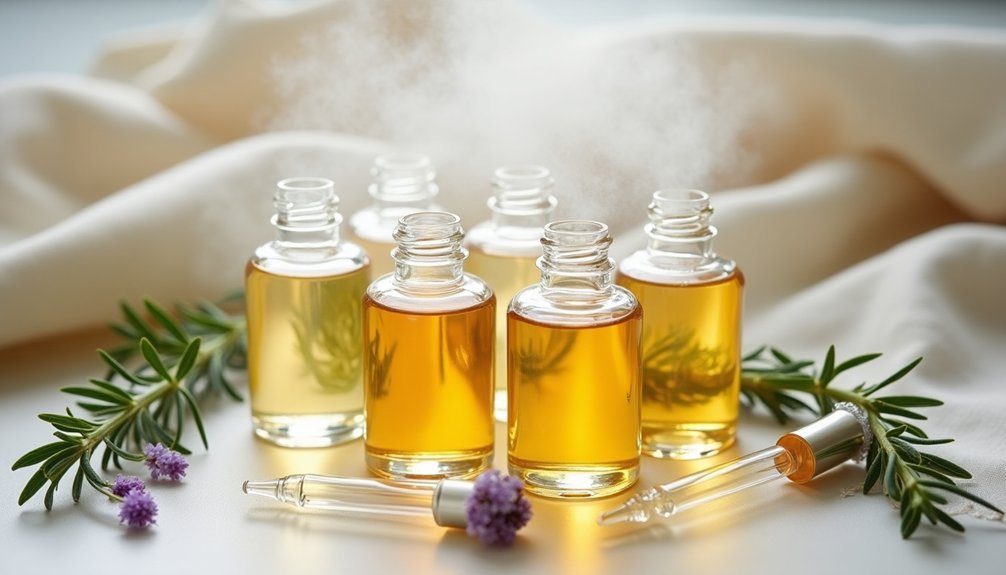
When exploring the world of perfumery, understanding concentration standards is essential for both creators and consumers. You'll find that perfume materials come in various concentration levels, each offering distinct characteristics and experiences.
The most common types range from Eau de Toilette at 10% fragrance concentration to the more intense Parfum at 20-40%.
Fragrances vary in intensity, with Eau de Toilette offering subtle elegance at 10% while Parfum delivers rich depth at 20-40% concentration.
If you're working with essential oils, a 10% dilution provides an ideal starting point, balancing potency with wearability. For stronger fragrances, you can increase the concentration – mixing 4g of essential oils with 6g of alcohol creates a powerful 40% dilution.
Remember that higher concentrations yield more intense scents, as demonstrated by the notable difference between 10% and 30% formulations. Adding fixatives to your natural perfumes will help extend their sillage and longevity.
Common Dilution Ratios for Different Fragrance Types
You'll find significant differences between fragrance concentrations, from the lighter 10% ratio of Eau de Toilette to the more intense 30-40% found in perfume extracts.
The balance between fragrant oils and alcohol carriers determines both the scent's potency and its lasting power, with higher oil percentages creating stronger fragrances.
When choosing your preferred concentration, consider that Eau de Parfum's 15-20% ratio offers a middle-ground option that's suitable for everyday wear.
Eau Vs Extract Percentages
Understanding fragrance concentrations helps you choose the perfect scent intensity for any occasion.
When you're selecting an alcohol based perfume, you'll find three main concentration levels that determine how strong and lasting your scent will be.
Eau de toilette contains 5-15% fragrance materials, making it ideal for daily wear with its lighter touch. If you're looking for something more impactful, eau de parfum offers 15-20% concentration, giving you better staying power and projection.
For the most intense and long-lasting option, parfum extracts pack the highest punch with 20-40% fragrance oils.
To create your own EDP, you'll want to follow the standard ratio of 15g fragrant material to 85g alcohol for a 30ml bottle. These percentages directly impact how your chosen scent performs throughout the day.
Alcohol-Oil Balance Basics
The precise balance between fragrance oils and alcohol forms the foundation of any successful perfume formulation.
You'll find two primary ratios that dominate the industry: a 40/60 split for stronger scents and a 30/70 mixture for lighter fragrances.
When you're working with a total of 10 grams, you'll need 4g of fragrance oils and 6g of alcohol for a 40% dilution, or 3g of oils and 7g of alcohol for a 30% blend.
For more economical options, consider a 10% dilution, which is common in eau de toilette preparations.
To guarantee accuracy, always weigh your materials rather than measuring by volume, as densities can vary considerably.
If you're creating topical applications with essential oils, stick to lower ratios between 1% and 3%, depending on the specific oil.
Essential Oil Measurements and Carrier Oil Balancing
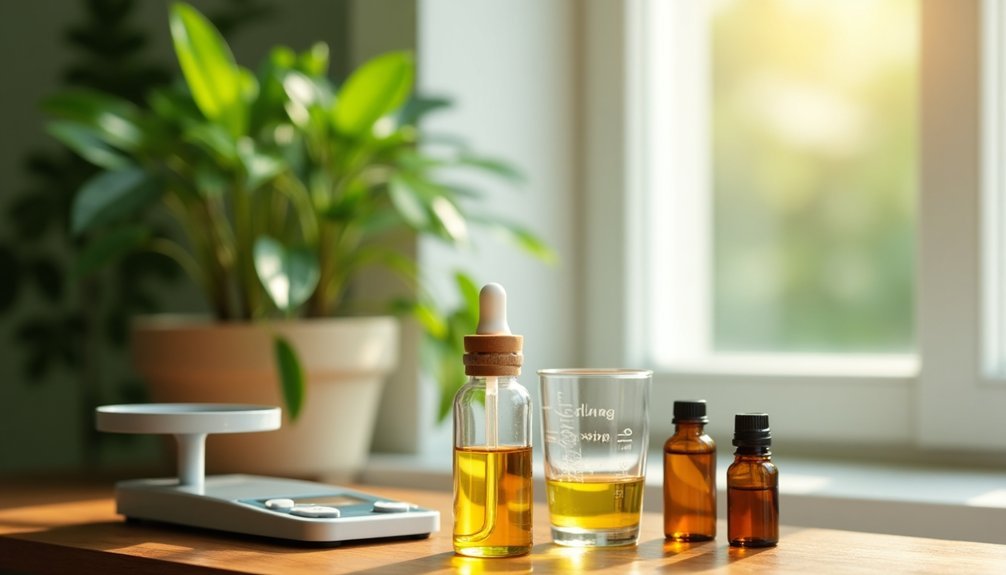
When working with essential oils, precise measurements and proper dilution ratios are crucial for both safety and effectiveness.
You'll want to aim for a 1-3% dilution rate for most topical applications, with 2% being your standard go-to concentration.
For a practical approach, mix about 0.5 oz of essential oil with 16 oz of carrier oil. Sweet almond and grapeseed oils make excellent carrier choices due to their neutral profiles and skin-friendly properties.
If you're working with stronger oils like peppermint, stick to a lower 1% dilution to prevent irritation.
Remember to take into account your carrier oil's density when calculating measurements. This affects your final blend's volume and guarantees you'll achieve the precise ratios needed for a safe, effective product.
Professional Testing Methods for Scent Strength
When testing your perfume's strength professionally, you'll need to conduct skin patch tests by applying small amounts to different areas and monitoring their performance over time.
You can track evaporation rates by weighing your fragrance samples at regular intervals and documenting how quickly they dissipate.
To measure scent projection, you'll want to create a testing grid where trained evaluators stand at various distances to assess how far your fragrance travels and maintains its integrity.
Skin Patch Test Methods
Professional skin patch testing plays an essential role in determining safe and effective fragrance concentrations for personal use. You'll need to apply your diluted perfume oils to a small area of your inner arm and monitor for reactions over 24 hours.
| Dilution Type | Starting Ratio | Test Duration |
|---|---|---|
| Essential Oils | 2% | 24 hours |
| Fragrance Oils | 1% | 24 hours |
| Natural Extracts | 1-3% | 24 hours |
When conducting your skin patch test, start with lower concentrations and gradually increase until you find your ideal strength. Your skin chemistry will uniquely affect how the fragrance develops, so personal testing is vital. Remember to document your results, including any reactions and scent intensity, to guide your future formulations. This systematic approach helps you create safe, personalized fragrances that work harmoniously with your skin.
Evaporation Rate Analysis
Once you've established safe concentrations through skin testing, the next step is understanding how your fragrance performs over time.
Professional evaporation rate analysis will help you determine the ideal dilution ratio for your desired scent longevity.
To analyze evaporation rates, you'll need to measure how different perfume dilutions behave under controlled conditions. Apply a specific amount of your fragrance to a testing surface and track its weight loss at set intervals.
Remember that your choice of carrier matters – alcohol-based dilutions will evaporate faster than oil-based ones.
Keep in mind that environmental factors play an essential role in your testing. You'll want to monitor temperature and humidity levels, as these can greatly affect how quickly your fragrance dissipates.
This data will guide you in adjusting your dilution ratios to achieve the perfect balance of strength and staying power.
Scent Projection Measurements
Measuring scent projection requires both human evaluators and specialized equipment to assess your fragrance's presence accurately.
Professional testers use a "sniff test" scale from 1-10, while advanced instruments like gas chromatography-olfactometry provide precise data about your scent's strength and reach.
When you use dilutions properly, you'll achieve ideal projection that suits your needs.
- Picture a perfume cloud extending from your body like an invisible aura, reaching outward several feet.
- Imagine trained evaluators walking through climate-controlled rooms, noting exactly where they first detect your scent.
- Visualize scientific instruments capturing and measuring each fragrant molecule as it disperses into the air.
Temperature and humidity affect how your fragrance projects, so consider these factors when choosing between different concentration levels, from eau de toilette to eau de parfum.
Calculating Perfect Ratios for Personal Blends
Creating the perfect fragrance blend starts with understanding precise dilution ratios.
When working with perfumery materials, you'll want to choose the right concentration for your intended use. Start with a 10% dilution by mixing 1g of essential oil with 9g of carrier for a gentle, skin-safe fragrance.
If you're aiming for a stronger scent, try a 20% dilution ratio, which uses 2g of essential oil per 8g of carrier – perfect for eau de parfum formulations.
For more intense blends, you can increase to 30% (3g oil to 7g carrier) or 40% (4g oil to 6g carrier), but always test carefully for skin sensitivity.
Safety Guidelines for Diluting Strong Fragrances
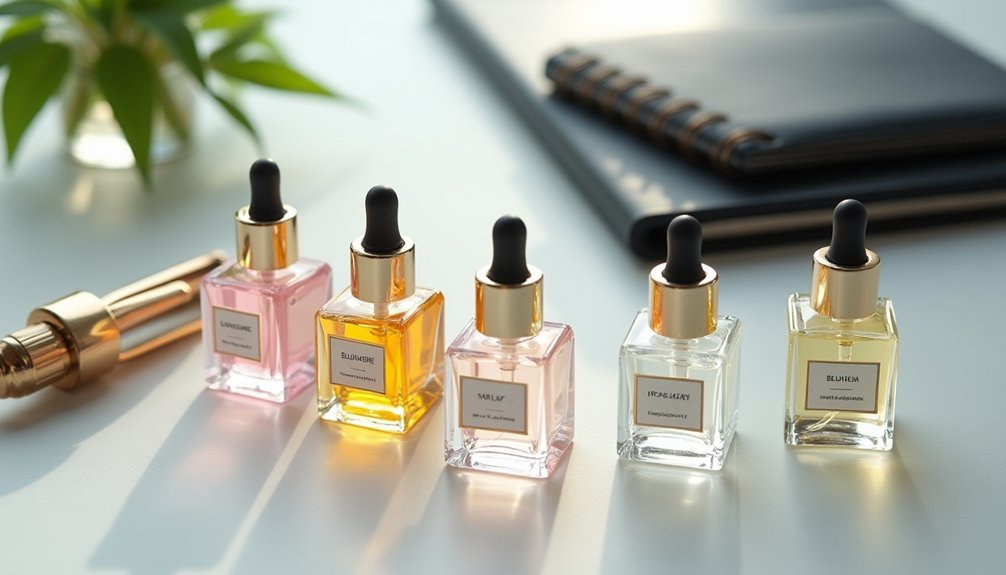
When working with concentrated fragrances, safety should be your top priority. Following proper safety guidelines helps prevent skin irritation and adverse reactions.
You'll want to stick to a 1-3% dilution rate for essential oils, with 2% being the sweet spot for most applications. Remember that certain oils, like peppermint, require even lower dilution rates.
- Picture yourself carefully measuring drops of fragrance into an amber glass bottle filled with carrier oil.
- Envision performing a patch test on your inner forearm, waiting 24 hours to verify no reaction.
- Imagine consulting a trusted aromatherapy guide, double-checking dilution rates for each oil.
Before applying any new blend, you'll need to conduct a patch test and use appropriate carrier oils like sweet almond or grapeseed.
Always perform a patch test and dilute with carrier oils before using new blends to ensure safe application.
Don't skip this vital step – it's your safeguard against potential skin sensitivities.
Adjusting Ratios Based on Oil Properties
Different fragrances possess unique molecular structures and potencies that directly affect their ideal dilution ratios. You'll need to adjust your dilution rates based on the specific properties of each oil to guarantee safe and effective results. While most fragrance oils work well at a 2% dilution, potent materials like ambrinol and oud maleki require more conservative ratios.
| Oil Type | Recommended Dilution | Carrier Oil Choice |
|---|---|---|
| Peppermint | 1% | Sweet Almond |
| Lavender | 2-3% | Any Carrier |
| Potent Materials | 1% or less | Heavy Carriers |
When working with essential oils, you'll want to start with lower concentrations and gradually increase them if needed. Remember that carrier oils aren't just diluents – they're vital components that enhance the overall fragrance experience while protecting your skin from potential irritation.
Troubleshooting Common Dilution Mistakes
Making precise dilutions requires careful attention to several key factors that novice perfumers often overlook. When you're working with perfume materials, you'll need to measure by weight rather than volume to achieve accurate ratios.
Don't forget to take into account the density of your materials, especially when working with alcohol-based solutions.
- Picture yourself carefully weighing each drop on a precise scale, ensuring exact measurements.
- Imagine creating a gentle 2% dilution that glides smoothly onto skin without irritation.
- Visualize organizing your workspace with properly labeled dilution charts for different materials.
Remember to adjust your dilution rates based on the specific oil you're using. Keep potent materials like Ambrinol 95 and oud maleki at 1% or lower, and reduce concentrations for strong essential oils like peppermint.
You'll avoid common mistakes by following these guidelines carefully.
Frequently Asked Questions
What Is the Best Dilution for Perfume?
You'll get the best results using a 15-20% dilution for your perfume. It's strong enough to last while remaining safe to wear. For beginners, start at 15% and adjust as needed.
What Is the 30/50/20 Rule for Perfume?
You'll balance your perfume composition by using 30% base notes for lasting power, 50% heart notes for core character, and 20% head notes for initial impression. This 30/50/20 rule creates harmonious fragrances.
What Is the Best Ratio for Perfume?
You'll get the best results using a 20-30% fragrance oil ratio with 70-80% carrier. For a stronger scent, use 30/70, or choose 20/80 for a balanced perfume. Adjust based on your preferences.
What Is the Best Mixture for Perfume?
You'll get the best perfume mixture by combining 20% fragrance oil with 80% carrier oil or alcohol. Start with 10 drops base notes, 5 drops heart notes, and 5 drops head notes for balance.
In Summary
You'll find that perfume dilution success comes down to careful measurement and patience. Start with standard ratios (15-30% for parfum, 8-15% for EDP, 3-8% for EDT), but don't be afraid to adjust based on your oils' properties and personal preference. Remember to test small batches first and always follow safety guidelines. With practice, you'll develop an intuition for creating perfectly balanced fragrances.
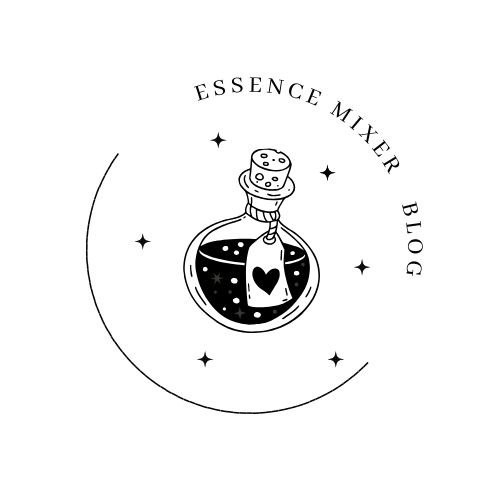
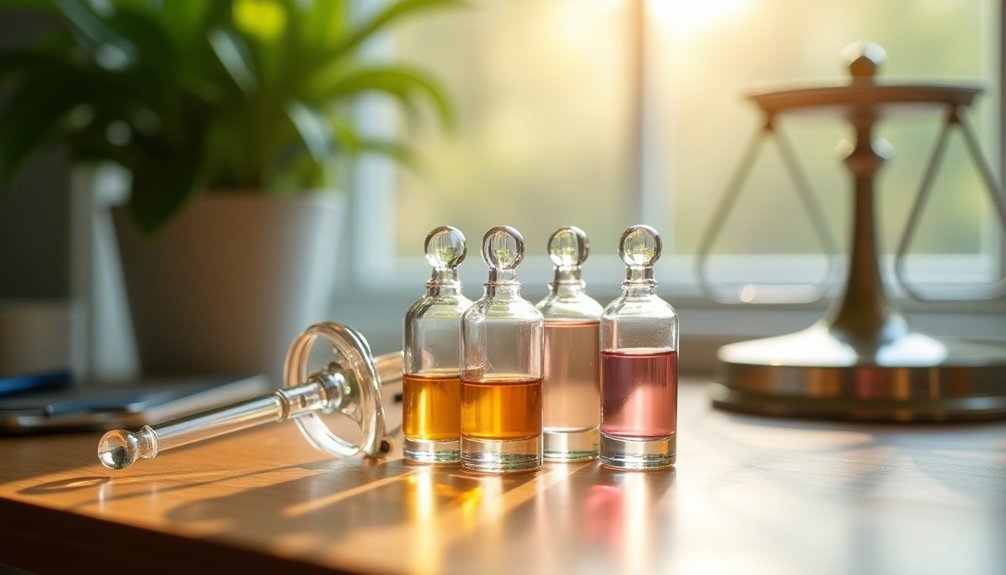



Leave a Reply